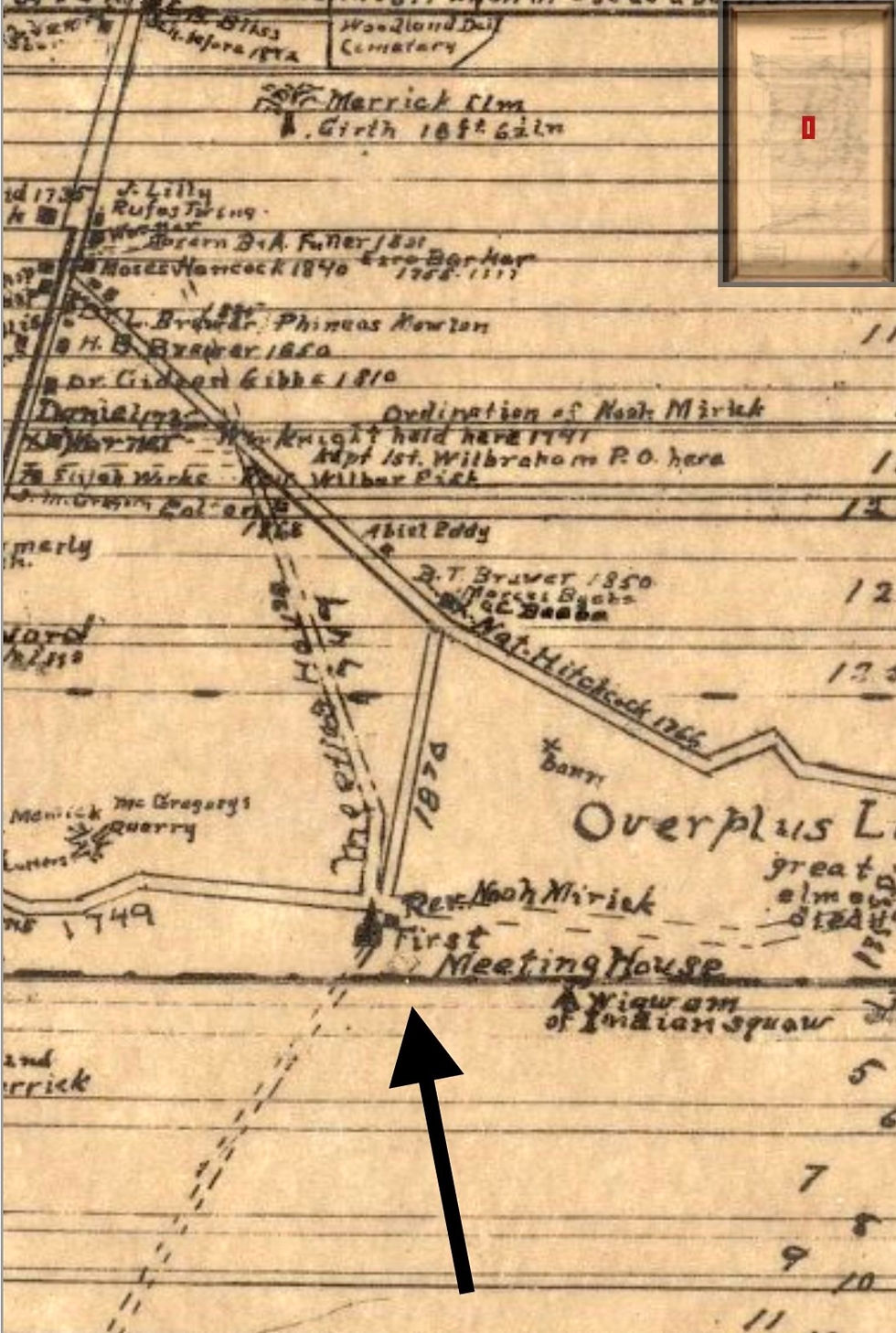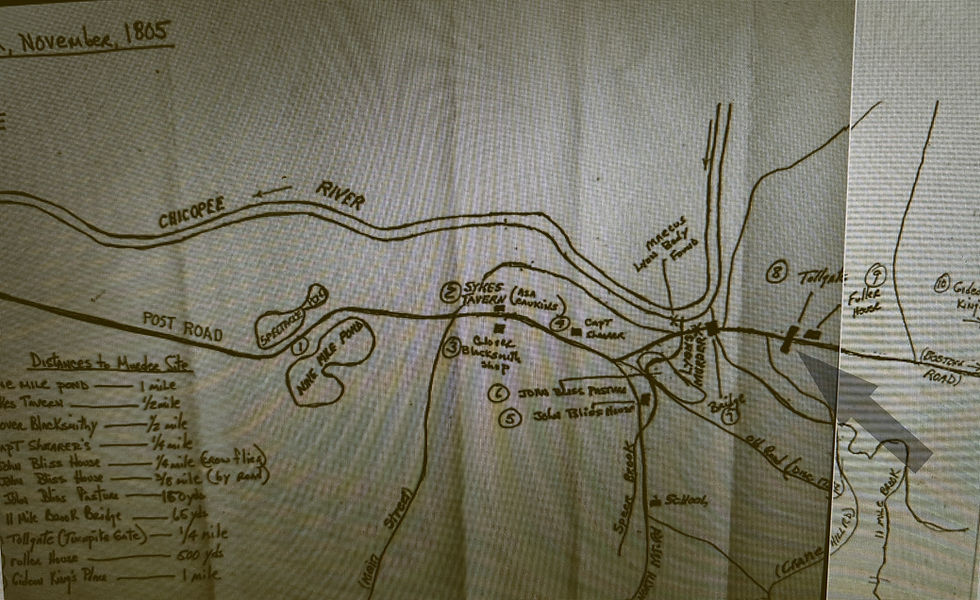The First Church of the Outward Commons on Springfield Mountain
- David Bourcier
- Nov 30, 2023
- 8 min read
Updated: 2 days ago
The land comprising the present towns of Ludlow, Wilbraham, and Hampden was originally known as the Outward Commons of Springfield, Springfield Mountain, or the Mountains.
Nathaniel Hitchcock, with his family in 1731, settled on the west side of West Road, currently 603 Main Street, Wilbraham. By 1740 twenty-five other families had also settled here. They all attended religious services at the First Church in Springfield which was about nine miles from their homes. On January 3, 1739, Springfield granted the residents of the "mountains" the preaching of ten Sabbaths at twenty shillings per Sabbath. The same amount was granted for the winters of 1740 and 1741. So, for the three winters, this saved them from making the tough journey in cold and snow to worship nine miles away.
In June of 1740, a petition was drawn up and presented to the General Court for the Outward Commons of Springfield to become the fourth precinct of Springfield. On January 6, 1741, it was granted by Jonathan Belcher, the Governor of the Massachusetts Bay Colony. There was a minor difference between the petition and the grant of it. The petition included all the land of the second and third divisions, but part of the second division was north of the Chicopee River in present-day Ludlow. In addition, the first division was completely left out. So the Fourth Precinct, as created by the General Court, included the lands lying southward of the Chicopee River, which include present-day Wilbraham and Hampden.
On March 12, 1741, the first precinct meeting was held at the house of David Merrick, who settled on West Road about 1735, currently 515 Main Street, Wilbraham. The precinct officers were elected, and six different meetings were held before June. At the meeting on April 17, 1741, the officers "unanimously voted a Call or Desire that the Worthy Mr. Noah Merrick should settle with" them "in the work of the Ministry."
In a letter, dated at Springfield, May 26, 1741, Mr. Merrick accepted the invitation with a salary or other commodities equal to one hundred pounds a year. In addition, a home is to be built for him and land made up from the overplus land in the middle division. By 1742, a fine home was built for Reverend Noah Merrick on Wigwam Hill, which today would be in the area of 1347 Tinkham Road, Wilbraham. In October of 1744, he married Abigail Brainard of Haddam, Connecticut. On their ride home to the minister's house, Abigail carried slips of a rose bush from her family home and planted them at their new home on Springfield Mountain. More about the roses, see the full story at https://david-bourcier.wixsite.com/wilbraham-tidbits/post/abigail-and-the-parson-s-rose-of-1744.
After a struggle of nearly seven years, the final decision was made as to where the Meeting House would be built. There has been great debate over the three locations where the meeting house should be built. The first location was on the "Green", West Road, today 678 Main Street, Wilbraham. The second location would have been on Pine Hill, the area today of Echo Hill Road, Wilbraham. The third location would be on Wigwam Hill, the area today of 1339 Tinkham Road, Wilbraham, this being the chosen spot, right near the Reverend Noah Merrick's home. By late 1748, the Meeting House was in use. The building itself was a mere shell for some years, and in January 1752, it was voted to further finish the Meeting House.

In 1763, the Fourth Precinct of Springfield was incorporated as a separate town, by the name of Wilbraham. In 1782, the town was divided into two parishes for religious services. The North and South Parishes of Wilbraham, with the South Parish known today as the town of Hampden. The South Parish built a meeting house in the village along the Scantic River.
Now with the two parishes, there was no need to have the Meeting House up on Wigwam Hill, and it was voted upon to move the building down to a more central location in the North Parish. It took twelve years of debating to either move the old Meeting House or build a new one. The location was also a topic of debate. So in 1794, it was voted to move the old Meeting House off the hill and temporarily relocate it in the middle of West Road, in front of what is now 500 Main Street today. This building was left in the roadway for two or three weeks until a permanent location could be made. This may account for the unusual width of Main Street in front of the current United Church because travelers went around both sides of the building. Several members of the parish desired that the building should remain there.
Interestingly, Charles Brewer, who was originally a congregationalist, was the first to be baptized in this first Meeting House up on the hill, on December 25, 1748. A few years before the building was moved, a vote was taken on August 29, 1791to move the meeting house down off the hill to a more central location in town. It was voted that the meeting house would be relocated to a parcel of land owned by Charles Brewer; however, three weeks later, the vote was rescinded. In voting not to use his land, the Parish's action resulted in Mr. Brewer and twelve others withdrawing from the First Parish and forming the Methodist Society.
In 1793, Charles Brewer offered the same property on the West Road (450 Main Street today) to the Methodist Society so that they could erect a meeting house. The rental of his property to the Methodists was one peppercorn yearly; this interesting agreement is documented in the lease. The Atheneum Society of Wilbraham, which currently occupies the building, continues leasing the property for one peppercorn annually from the Town of Wilbraham, which owns the property today.
The building was finally moved from the middle of the road to its permanent location, which is today, Gazebo Park on Main Street in the center of town.
During the ministry of Reverend Ezra Witter (1797-1814), the old Meeting House was repaired, and in 180,2 a church bell was purchased and hung. This was "the first Sabbath bell of the Mountains."
In 1857, the old Meeting House was moved to what is now Burt Lane, near the livery stable, and converted into a horse shed. A more spacious structure was built, with four large windows on each side, a basement, and a beautiful tower. Unfortunately, on Sunday, June 24, 1877, this building, along with six others, which included the old Meeting House that was converted into a horse shed, burned to the ground by a very destructive fire that struck the center village. According to the report, "a mischievous boy crawled through a basement window, got up on a chair, and reached the can of matches high up in a cupboard." He then proceeded to light papers in a stove to which the chimney pipe wasn't connected.

After the fire, the Congregationalists needed a place to worship. The Methodist Society, whose brownstone church stood just north on Main Street, voted to invite the Congregational Brethren to use their church for worship until their church could be rebuilt. From July 1, 1877, to August 26, 1877, both societies worshipped together, and the ministers from each would alternate in the preaching. The,n until February 3, 1878, they had separate services. For the first time in 85 years, the two churches advanced from a rivalry in which stones were thrown and citizens were jailed to getting along and having acceptance of each other.
One year later, the third Meeting House was built on this same property and was dedicated on June 26, 1878. This new building was more elaborate than the previous, with two spires, the main one "very high and graceful," two tower entrances from the street, and a large rose window on the north side, no doubt a tribute to Abigale Merrick, wife of the first minister, Reverend Noah Merrick. The new 1,662-pound bell incorporates part of the old bell, which was given by Ethan C. Ely of Longmeadow in memory of his family that lived in Wilbraham.

On July 5, 1911, disaster struck again, a fire tore through the third Meeting House, which was caused by a lightning strike from a passing wind and electrical storm. The fire started at the very top of the highest spire and worked its way down until the entire building was destroyed.
Once again, the Congregationalists needed a place to worship until this church could be rebuilt. The Methodists came to the rescue by offering their place of worship in the brownstone church, as they had done in the past.
The fourth Meeting House that was built was not as elaborate as the previous two. It was a gray shingled building with white trim and a slate roof. It was dedicated on May 11, 1913, at a cost of $17,000. A new bell containing the metal salvaged from the old bells was cast and installed in 1916, a gift from Mrs. Lucia S. Foskit and Mrs. Laura H. Bruuer.

From this point in the rebuilding of the fourth Meeting House, both Congregationalists and Methodists have united. Both churches were utilized, from May 1st to October 31st, the Methodist Church was used, and from November 1st to April 30th, the Congregational Church. All social activities were conducted in the Congregational Church due to its having a dining room and kitchen, and other rooms used for social purposes.
In 1941, the Methodist Society Church, made of brownstone, was transferred to Wilbraham Academy due to decreasing numbers of worshippers, and its parsonage was transferred to Wilbraham United Church. Both Societies are now under one roof.
The sanctuary was completely remodeled, and an ell wing was added for educational use in late 1949, with a dedication to the enlarged building on April 30, 1950.
A new colonial brick church was built by Wilbraham United Church just south of its previous location at 500 Main Street and was dedicated on March 23, 1958. The old Congregational building continued and was used for dinners and other social activities. It was also used by a newly formed Episcopal Church group for worship until it was razed in December 1962.

Today, this church still plays an active role in worship in the community. The Church remains a merged congregation of the Congregational and Methodist Societies. Since 1913, the two denominations have worked well together as one church body.
This congregation is a unique and inclusive community that draws from the traditions and values of both the United Church of Christ and the United Methodist denominations. This blend of traditions allows them to celebrate diversity and promote a sense of unity. Their emphasis on love as the most important value aligns with the teachings of both denominations, which often prioritize love, compassion, and care for others. Additionally, valuing wisdom and laughter equally suggests a well-rounded approach to life, recognizing the importance of both seriousness and joy in one's faith journey.
Finding joy in the work they do together is not only focused on worship but also on active engagement in service and community-building activities. This holistic approach to spirituality can create a vibrant and supportive community for its members.




Comments